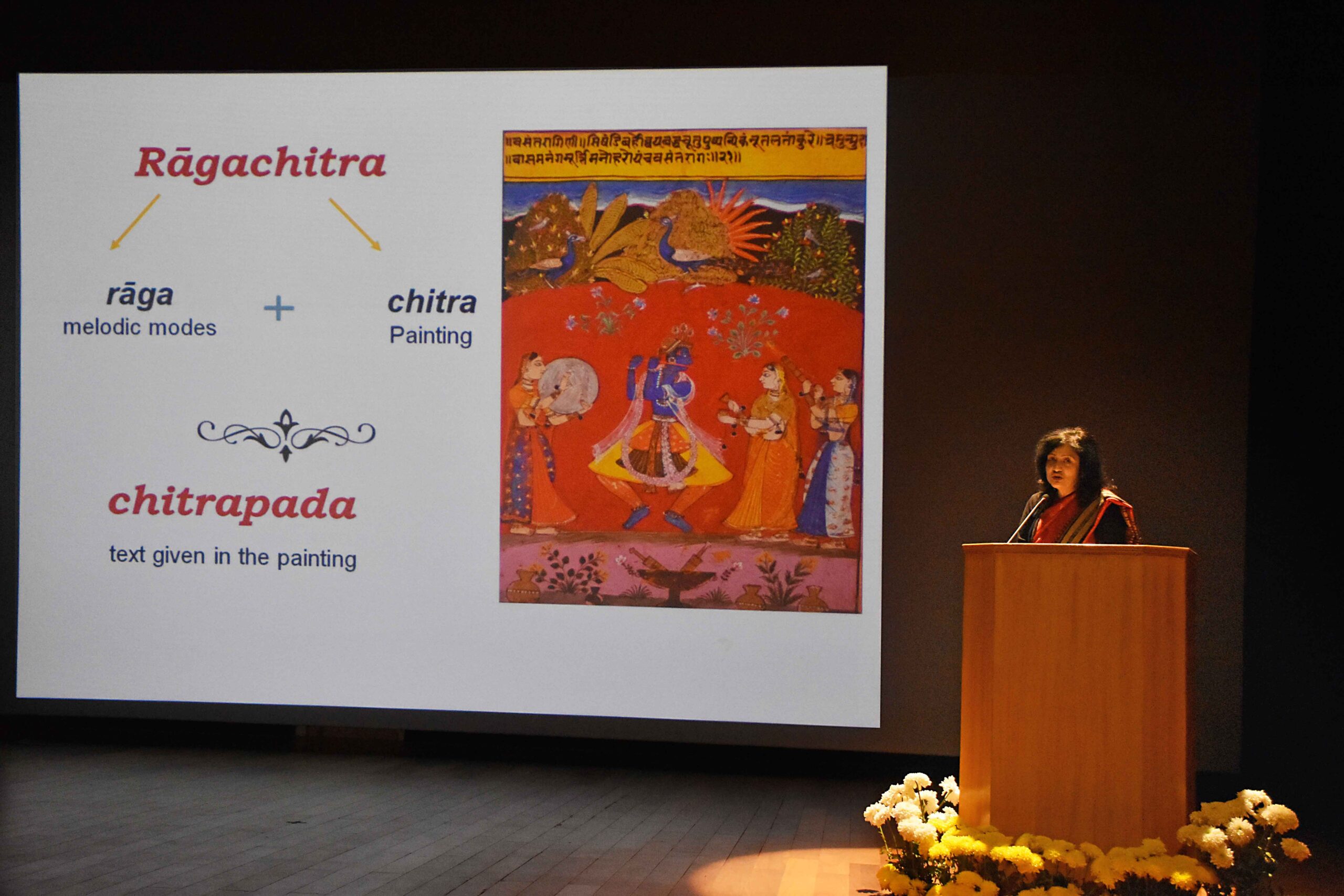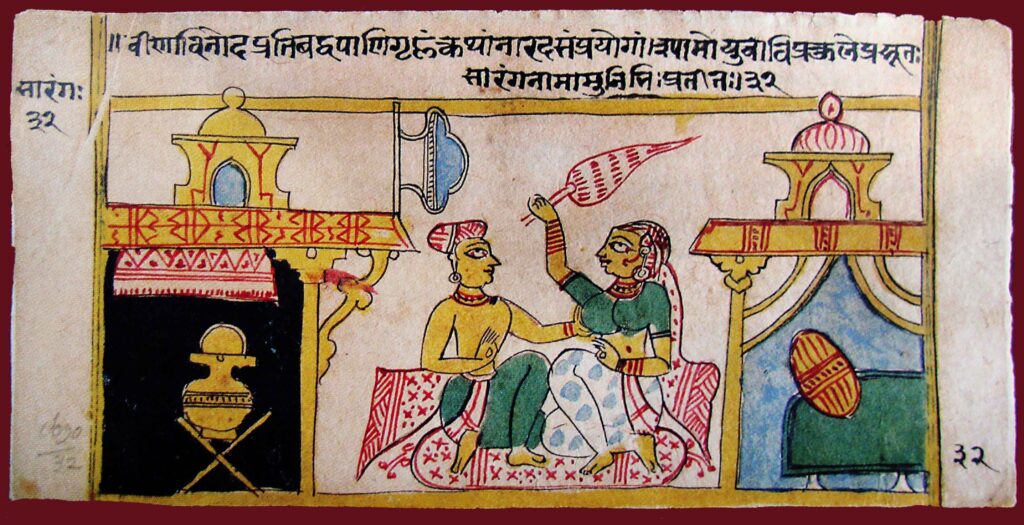Concept and Visualization of Ragachitra: Gem Palace collection of the National Museum, Review of National Museum Public Lecture by Gaurav Kumar

curator, Learning and education department, National Museum,
New Delhi
The Professor and Head of the Department of History of Art, Director, and Pro Vice-Chancellor of the National Museum Institute of History of Art, Conservation, and Museology [soon it will be known as The Indian Institute of Heritage (IIH)], Prof. (Dr.) Anupa Pande, was invited to give a talk titled “Concept and Visualisation of Ragachitra: Gem Palace Collection of the National Museum”. This talk was held on November 25, 2022 at the National Museum, New Delhi. The National Museum, New Delhi, organized it.
Prof. (Dr.) Anupa Pande began her talk by introducing the concept and Visualization of Ragachitra; she stated that Ragachitra is a unique genre of miniature painting that combines visual and performing art forms. She then went over the essential components of the Ragachitra, Visualization, and meaning of the Ragachitra (Rāga– melodic modes and Chitra– painting). And the importance of Chitrapada, Chitrapada (the words presented in the painting/Ragchitra) accentuates the grandeur of the Ragchitra.
The vastness of this public lecture and the limitation of the Magazine’s page stops me from going into great depth. Still, the following information will offer you a preview of the presentation titled “Concept and Visualization of Ragachitra: Gem Palace Collection of the National Museum”.
The talk was focused on investigating the basic notion of Ragachitra by looking at the reserved Gem Palace collection, which is now preserved in the National Museum, New Delhi. It essentially dealt with deciphering the meaning of a Ragachitra, its genesis and iconography through the lens of a meticulous methodology. As an expert in the Sanskrit language, a trained classical music performing artist and an art historian, Prof. (Dr) Anupa Pande has utilised only original sources (not translations) and all the original text or old Devanagri script was deciphered/translated by herself, which form a strong foundation for her research on this study And authentic and correct understanding for the perceivers. They can be broadly categorized as texts that deal with the music and the various nuances of raga paintings.
The lecture was painstakingly researched from original sources, including various ancient and mediaeval Sanskrit treatises on play, music, and iconography. These include Nāṭyaśāstra, Kāmasūtra, Bṛhaddeśī, Bharatabhāṣya, Nāṭya Darpaṇa, Abhinavabhāratī, Sarasvatīkaṇṭhābharaṇam, Aparājitapṛchchhā, Mānasollāsa, Saṁgītaratnākara, Saṁgitarāja, Rasamañjarī, Ujjvalanīlamaṇi, Saṁgītopaniṣat Sāroddhāra, Rasakaumudī, Rasikapriyā, Rāgavibodha, Saṁgīta Darpaṇa, Rāgamalā etc.
The presentation was divided into three sections. The first section outlines the history of Indian music; the second section elaborates on the process of transforming the aural component, raga, into the visual component, rgachitra. The third section examines selected rgachitra folios from the Gem Palace collection in terms of theme, iconography, and literary content.
The talk continued with an explanation of the criterion for selecting the artworks, which have been to depict various seasons, deities, Rasa along with Nayaka-Nayika bheda.
For all this duration I was mesmerised by the presented collection in this lecture. Vasanta Rāginī, (c.1640 C.E. ), Dhanasri Rāginī (c. 1640 C.E.), Hindola Raga (c. 1640 C.E.), Asavari Ragini (c. 1640 C.E.), Bhairavi Ragini, (17th-century C.E.) and Khambhavati Ragini (17th-century C.E. ) are a few examples that were mentioned and shown during the lecture. In Vasanta Raga’s painting, she beautifully explains the painting to the viewers “In Indian culture, the season of spring is synonymous to the melodious sound of koel and mango sprays, mentioned in the Chitrapda, a convention which has been consistently followed by the artist for this ragachitra as well. It is noteworthy that the oral and visual traditions of Vasant continue with these specific aspects even until the 20th century, as is evident in the popular Indian Cinema music,”she said.

National Museum, New Delhi
All image Courtesy: Department of History of Art, National
Museum Institute
To sum up this review, I believe that the huge repertory of Indian miniature painting is a vital part of our legacy. Painted largely for royal and courtly consumption, this art flourished throughout the kingdom beginning in the 16th century and led to the formation of various schools. Among the many subjects that found expression in the visual media, a separate genre representing melodies of classical Indian music or ragas and raginis developed in Rajasthan, Malwa, the Punjab highlands, and the Deccan from the 16th to the 19th centuries. These paintings, known as ragachitras, combined the auditory and visual and were done with zeal. Ragachitras were created to immortalize songs through deification and personification, sometimes imbuing them with deeper meaning. Certain ragas and raginis were also depicted based on their performance or the emotion or rasa that they evoked. The specific/formulaic iconography allocated to each type results in a visually distinct design. The lecture was not only Informative & interesting for scholars, art students and art lovers, but it was also captivating to hear one of India’s top art historians, Prof. (Dr.) Anupa Pande, speak.
Read More>> Please Subscribe our Physical Magazine
